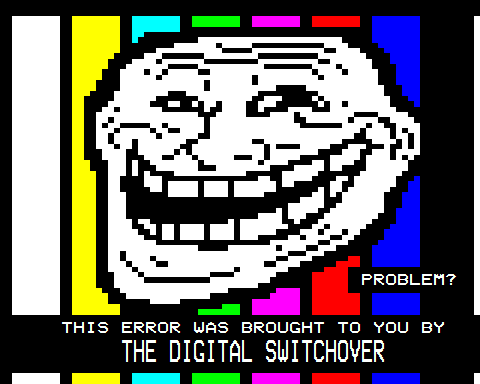Reached some good concepts for final outcomes, such as recontextualising existing information broadcast systems for a more technologically advanced age, for example, how the aesthetic of teletext would be transmitted via mobile phones, computers or even HDTV.
Done some fairly basic experiments for outcomes. These include exploring the possibilities for converting the medium of teletext to the digital form, in particular the web browser. Experimented with Flash, HTML and the Cebra Teletext editor to create a (and use the) visual aesthetic.
An initial project aim was to find out to what extent teletext was a precursor to the internet. I researched early web networks, video games and other similar media and found that teletext was in fact the first commercially successful electronic public information retrieval system. Thus, teletext and its functions and methods were influential in the early days of the web even if the aesthetic, which was largely determined by the medium, was not. In other ways, though, teletext remains unique. For example, the number entry page navigation system has not really been emulated by any subsequent technology.
 A second aim was to look into some of the artists that use teletext as a medium for producing work. Found that this method is much more popular in Europe, where teletext is still a priority. Lektrolab’s user submissions project was a good example of this, with the general public creating their own teletext pages for transmission on Dutch teletext. Enthusiasts extend the reach of the medium by creating home made teletext systems for their website, such as Tarmo Tanilsoo, who uses the web browser as a teletext browsing tool by emulating the format.
A second aim was to look into some of the artists that use teletext as a medium for producing work. Found that this method is much more popular in Europe, where teletext is still a priority. Lektrolab’s user submissions project was a good example of this, with the general public creating their own teletext pages for transmission on Dutch teletext. Enthusiasts extend the reach of the medium by creating home made teletext systems for their website, such as Tarmo Tanilsoo, who uses the web browser as a teletext browsing tool by emulating the format.In addition to this, artists still allude to pixel design, and look to utilise the idea of ‘extreme pixellation’ due to its distinct aesthetic and recognisibility. There is also an element of nostalgia in some cases – many will be sad to see teletext in its traditional form, with its traditional asthetic die out.
Finally, for the conceptual/historical aspect, I have a greater understanding of the historical timeline of the medium, from its inception in the 1970s to the switch off in 2012. In the UK, the medium ‘survived’ technological updates due to accessibility problems with level 2 and level 3 teletext, but also because people continued to use it as their main source of information.
Things are going along pretty much to plan with regards to the project. The weblog is providing a useful resource to compile and organise data. As an addition, the microsite has been a useful way of testing out presentation methods, albeit within the HTML browser restriction.
I now need to select information from the weblog and decide how it needs to be presented. With regards to this, I have a range of options open to explore further. From these I will choose the most appealing to develop into a project.



0 comments:
Post a Comment